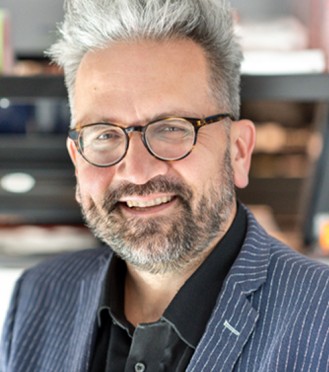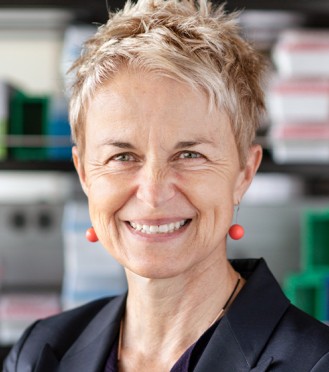Gladstone NOW: The Campaign Join Us on the Journey✕

Senior Investigator Melanie Ott, MD, PhD, knows studying organoids can lead to drug therapies for COVID-19.
Like other viruses, COVID-19 could be treated with an antiviral drug. Unlike other viruses, there is no known antiviral that specifically treats this virus. Senior Investigator Melanie Ott, MD, PhD, wants to change that.
While most antivirals target the viral proteins themselves, Ott is looking for antiviral drugs that target host proteins. These antivirals would “starve” the virus from the host resources that allow it to reproduce. Moreover, there is a better chance of long-lasting effectiveness if the antiviral targets host proteins as they mutate at a slower rate than viral proteins. To get closer to finding the antiviral effective against COVID-19, Ott and her team are testing drugs in primary lung models including lung organoids, three-dimensional tissue cultures that replicate the features of the larger organ.
By using primary lung models for screening potential treatments, the team increases the chance that their discoveries will translate to therapies that will be effective in people. Although much smaller, a lung organoid resembles the functions and features of the actual organ. “With our collaborators, we grow organoids either from iPSCs or from the stem cells of the full-size organ, and because they are closer to the real thing, we get a better picture of how lungs react to different treatments,” explains Ott.
The therapeutic approach Ott’s team is pursuing—targeting the host proteins rather than the virus to stem infection—is one she and Nevan Krogan, PhD, have prioritized for a while. While the SARS-CoV-2 virus appears to mutate at a slower rate than other viruses, for instance HIV, human cells mutate even slower. Any antiviral developed based on the viral proteins would quickly become irrelevant by the rapid mutation of the virus. An antiviral against the host proteins will last longer, and also has the potential to be repurposed for other viruses.
Ott’s team takes advantage of a comprehensive map of the interactions between the virus and host proteins. This map was generated by a team of researchers led by Nevan Krogan, who has previously created similar maps for other viruses like HIV and Zika. With the map in hand, Krogan, Ott and their colleagues have already identified host proteins to target and prioritized FDA-approved or pending approval drugs that should be screened for potential antiviral effectiveness.
Now Ott’s team is prepared to use the lung organoids and other lung models to screen these drugs and others, as new candidates arise from additional studies of host and virus interactions.
The two approaches to finding effective drug therapies taken by the Gladstone team are powerful on their own. The focus on screening FDA-approved drugs avoids the lengthy approval process. Using lung organoids to screen potential therapies bypasses simpler screening methods saving time in identifying effective treatments. By combining these approaches, Ott’s team hopes to create a faster pipeline to usable drugs.
Support Our COVID-19 Research Efforts
Gladstone scientists are moving quickly to respond to the coronavirus outbreak. Help us end this pandemic.
Science in Seconds | Researchers Pinpoint Key Gene Behind Heart Defects in Down Syndrome
Science in Seconds | Researchers Pinpoint Key Gene Behind Heart Defects in Down Syndrome
In this video, Gladstone scientists share how they used stem cells, gene editing, and AI to identify a gene driving heart defects in Down syndrome—and how reducing its levels in mice restored normal heart development, offering hope for future treatments
Gladstone Experts Cardiovascular Disease Data Science and Biotechnology Pollard Lab Srivastava Lab AI Big Data CRISPR/Gene Editing Human Genetics Stem Cells/iPSCsScience in Seconds | The Thinking Microscope: Research Powered by an AI Brain
Science in Seconds | The Thinking Microscope: Research Powered by an AI Brain
In this video, Steve Finkbeiner and Jeremy Linsley showcase Gladstone’s groundbreaking “thinking microscope”—an AI-powered system that can design, conduct, and analyze experiments autonomously to uncover new insights into diseases like Alzheimer’s, Parkinson’s, and ALS.
Gladstone Experts ALS Alzheimer’s Disease Parkinson’s Disease Neurological Disease Finkbeiner Lab AI Big DataVisualizing Stem Cell Technology: An Animated Explainer
Visualizing Stem Cell Technology: An Animated Explainer
In this animated short, Deepak Srivastava explains how scientists can reprogram ordinary skin or blood cells back in time—turning them into induced pluripotent stem cells which are capable of becoming any cell type in the body.
Gladstone Experts Stem Cells/iPSCs





